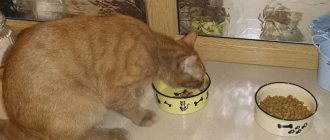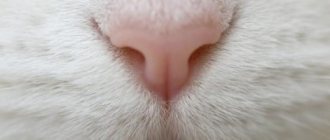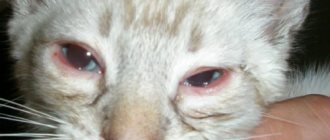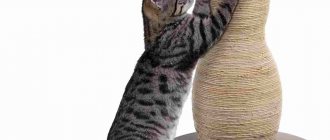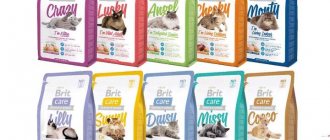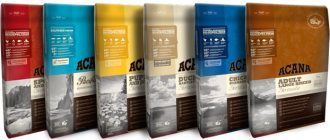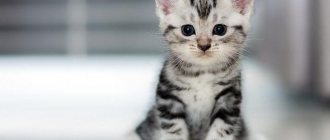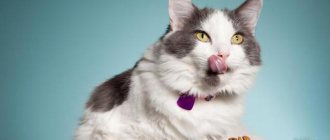Mixed food is dangerous for the stomach and intestines, so veterinarians strongly recommend using only one type of food: natural or ready-made.
Despite this, it is not possible to choose a convenient option right away. For this reason, owners have to engage in retraining, which does not always go smoothly. Below you can find out how to switch a kitten or an adult animal to dry food and what to do in case of a hunger strike.
Why transfer an animal to drying: pros and cons
Dry food is often viewed with skepticism, as many owners are sure that such food causes urolithiasis. In fact, kidney stones are formed due to insufficient fluid intake or low-quality products. The main disadvantages of “drying” are associated specifically with economy class.
If you choose food thoughtfully and correctly, you can find the following advantages:
- variety of lines (food for kittens, pregnant women, the elderly, castrates, allergy sufferers);
- balanced composition that does not require independent calculation of BZHU;
- saving time;
- no risk of parasite infection;
- prevention of tartar formation.
If we put aside banal convenience, then the main reasons for the forced transfer to “drying” are illnesses and excess weight. The menu of a therapeutic diet with natural products is usually very meager and takes a lot of time to prepare, so most veterinarians recommend not torturing yourself and your pet - and just buy the right food.
What “surprises” may lie in wait for you?
The transition to natural raw food occurs differently for different dogs. The age and health status of the pet plays an important role in this. The older the animal, the more difficult it is for its body to accept a new feeding scheme. Such animals need more time to get used to and learn to assimilate foods “unknown” to the body.
So, what can change when switching your pet to a raw diet?
Detoxification
The transition from commercial food to natural raw food causes the body's need to remove waste and toxins. Excretion occurs through the intestines, skin and glands.
Depending on your health condition, the detoxification period may last one or several weeks and be accompanied by the following symptoms:
- Nausea.
- Diarrhea.
- Hair loss.
- Dermatitis and dry skin.
- Copious discharge of earwax.
- Discharge from the eyes.
If one or more signs appear, you should not immediately panic and think that the dog is sick. In fact, these are the first signs that the body is getting rid of harmful toxic substances, the ears and anal glands are being cleansed. A little time will pass and you will see noticeable changes for the better: shiny coat, firm muscles and elasticity of the skin, good appetite and excellent physical activity.
Changing the stool
After switching the dog to a natural raw diet, there will, of course, be a change in the quality of the stool. Since natural food contains more high-quality and useful microelements, they are perfectly absorbed by the body, leaving a much smaller pile volume at the output than you are used to seeing with dry feeding.
The quality of the stool will directly depend on what your pet ate. Don’t be alarmed if you find pieces of undigested carrots in your poop, for example!
The color of the stool may also vary in color and consistency. If the dog has eaten more bone products or cottage cheese, the stool will be light, almost white. But excessive consumption of offal can cause disorder.
It should be remembered: if diarrhea lasts for a long time, this is a reason to consult a veterinarian. However, you should also not confuse diarrhea with “soft” stools. Over time, you will learn to control the process of combining products, and the stool will become “uniform”.
Reduced water consumption
Don't be alarmed if your dog drinks less water when switching to a natural diet. The fact is that the pet begins to eat fresh, moisture-filled foods. Barbos may not go near a bowl of water for several days. But this does not mean that it should be removed. Fresh, clean water should always be freely available and in sufficient quantity.
Choosing dry food
Thanks to the right choice of food, most of the problems that arise when accustoming to a new food can be avoided. To do this, you will need to take into account the individual characteristics and taste preferences of your pet, as well as correctly calculate the volume of the daily portion.
Individual characteristics of the pet
The most important criteria include age, activity level, health, as well as the presence or absence of castration, pregnancy and lactation. A high-calorie diet is required for kittens, hyperactive, pregnant and lactating cats, and a low-calorie diet is required for elderly, lazy and neutered cats.
IMPORTANT!
Choose products that are at least premium. Cheaper foods contain little animal protein and often cause allergies.
If you have chronic or acute diseases, you should choose a treatment line based on the diagnosis. Many manufacturers produce special “crackers” recommended for animals with obesity, gastrointestinal pathologies, renal failure, allergies, diabetes and urolithiasis.
Taste preferences
If you are not sure what exactly your pet likes, then give him a week of tasting, buying one brand with different tastes. In addition to classic chicken and turkey, the store offers salmon, duck, lamb and rabbit. Exotic types of meat usually cost more, but they almost always satisfy picky eaters with a mustache.
ADVICE!
Don't give up prematurely. In addition to the taste, the animal may not like the smell, shape or consistency of the product. That is why it is recommended to try different manufacturers at first.
Calculation of serving volume
Usually the recommended serving size is indicated by the manufacturer himself. It depends on the weight of the animal and the calorie content of the product. The latter is often different, so don't be surprised if the norms for your pet don't always match.
If you are obese, it is better to calculate the daily portion yourself. The simplest formula suggests taking 5% of body weight as an example, and the most accurate one uses a special coefficient that takes into account the physiological characteristics of the animal.
Please note that the volume of “drying” will always be less than “natural”, since the calorie content of ready-made feed is much higher.
“ Learn more about how to calculate a portion of pet food
Step-by-step transition from “natural”
When changing your usual diet, it is very important to adhere to the principle of stages. Too abrupt a transition to a new type of food will cause not only the indignation of the “mustache”, but also problems with the gastrointestinal tract.
Introducing new foods
The first impression is the most important, so you should start your acquaintance with a little trick. Soak the granules in kefir or meat broth. Their smell and consistency will change and become more familiar and attractive to the cat.
If the “mustache” still left the food aside or pointedly threw it out of the bowl, do not rush to give up. Grind the “crackers” into smaller pieces, mix with your pet’s favorite dish and offer again, but for another meal.
Smooth substitution of one food for another
When different types are mixed, short-term intestinal upset occurs. It will normalize on its own after the transition is completed. Recommendations for replacing one food with another are as follows:
“a. the first 4 days – 75% “natural” and 25% “drying”;
b. Days 5-9 – 50% of each type;
c. Days 9-14 – 25% “natural” and 75% “drying”.
After 2 weeks, the pet is fed only “crackers”. All this time, special attention is paid to the drinking regime, since a lot of liquid is required to absorb solid granules.
Drinking regime
When feeding dry food, it is recommended to drink 2 times more than what you eat. If your pet doesn't drink enough, make sure he likes the bowl and where it sits. Many cats gravitate towards running water, but drinking from the tap is too dangerous. Instead, use a drinking fountain with built-in filters that remove heavy metals.
“ More about fluid standards for cats
What can you give your cat?
The main components of natural cat food are:
- fish is a favorite product of fluffy beauties; marine varieties are recommended, both raw and boiled. Boiled fish should be cleaned of bones; they can be easily separated from the pulp; they can be swallowed unchewed or get stuck in the esophagus;
- meat - lean chicken, beef, lamb, rabbit, horse meat, scalded with boiling water, are allowed. Pork is banned;
- by-products - liver, lungs, heart, kidneys - are introduced into the diet 2 times a week - their nutritional value and usefulness are low. If there are signs of poor digestion: vomiting, diarrhea, by-products are excluded from the animal’s menu;
- fermented milk products - kefir, cottage cheese, medium-fat starters. Low-fat foods cause stool upset. Cats do not tolerate milk well - the number of enzymes that break down lactose decreases with age;
- vegetables - any are allowed: cabbage, carrots, peppers, pumpkin. A combination is possible. They are given in crushed raw form and can be mixed with meat. Potatoes - excluded;
- eggs - chicken or quail are suitable. The yolk and white are mixed. Serve separately or with kefir and cottage cheese.
A pet’s illness or surgery is a reason to contact a veterinarian to correct the animal’s nutrition.
Chicken necks have proven themselves well for natural feeding of cats. They are prepared as follows: mince twice through a meat grinder to grind hard bones, add a little boiled rice or buckwheat, and grated carrots. They mix.
Natural food is natural healthy nutrition for your feline. With good care, a kind attitude, a positive attitude of the owners, and a well-designed feeding diet, the animal will be healthy, happy, and will live a long, fulfilling life next to its owners.
Switching from pates and pouches
Veterinarians criticize the mono-nutrition of pates and meat pieces from spiders, since such food softens the gums, increasing their bleeding and the likelihood of premature tooth loss. If you have accustomed your pet to such a diet, then it should be changed to mixed or dry.
Alternation method
This method does not involve a complete transition, but it allows you to reduce the amount of wet food in favor of dry food. Such nutrition has a beneficial effect on teeth, as it does not overload the gums and cleanses the enamel of tartar.
Here you can choose 2 options: alternate food by day or meal. For faster adaptation, the granules should be soaked in meat juice from wet canned food for the first time.
Mixing method
The mixing methods when switching from wet canned food to natural food are similar. The only difference is faster adaptation, the mandatory choice of one brand of products and careful adherence to the standards indicated on the packaging.
In most cases, cats get used to the new type of feeding within 7 days. For the first 2 days, it is better to serve the croquettes in crushed form, so that the mustachioed picky eater is not too outraged by the unusual consistency.
Natural or balanced food for adult cats?
Many cat owners choose dry food for cats and kittens, but some remain committed to the misconception about the benefits of raw meat, fish and fresh dairy products. Myths about the benefits of “natural food” for felines have long been dispelled by veterinarians, manufacturers of pet diets, and store specialists in the selection and sale of all types of food. Compared to meat, fish and other products, ready-made pelleted feeds have many advantages:
- Balanced – dry cat food should consist of proteins, fats, carbohydrates, digestible fiber, and a vitamin-mineral complex; it is best to purchase them in specialized online stores.
- Easy dosage according to the age and weight of the animal;
- Ease of combination of dry/wet food and traditional products;
- Elimination of poisoning, which often occurs when feeding meat/fish with a large amount of premixes;
- The ability to choose daily, preventive and therapeutic dry food for cats of any age group.
When and how to switch a kitten to dry food
Eating cat “crackers” is impossible without teeth. For this reason, it is necessary to start from this criterion.
Optimal age to get acquainted with drying
Kittens' first teeth appear 2-3 weeks after birth. From this moment on, complementary foods are added to breast milk. Children are introduced to either wet canned food or “crackers” soaked in boiled water.
Feed selection
Choose products designed for kittens and pregnant cats. It is high in calories and rich in calcium. Babies need both for quick saturation and proper development of the body.
Gradual transition to dry feeding
The transition of a kitten to dry food should also be gradual. At first, croquettes are given in minimal quantities, replacing only 1 meal. The single portion and frequency of dispensing are increased progressively, carefully recording the body's reaction.
If the cat does not have problems with lactation, wait for the natural interruption of breastfeeding before completely eliminating milk. In all other cases, only 7-10 days will be enough for the transition.
Useful tips
Few people know that dehydrated pieces of meat in the diet of animals appeared 160 years ago in 1860. There is still debate about the disadvantages and advantages of this product.
Feed selection
Only those owners who purchased economy-class products for their pets could have a clearly negative opinion about industrial food. It contains components that are useless for regular consumption: soy, cereals, offal instead of meat. The attractive aroma of the lumps is created using chemical flavors and flavor enhancers.
When choosing a product, you should give preference only to high-quality products and a trusted manufacturer
It is important to carefully study the composition on the packaging. The following components should be listed there:
- fresh and dehydrated meat;
- eggs;
- vegetables and fruits, sometimes seaweed;
- fish fat;
- amino acids;
- cereals;
- vitamin and mineral complex.
Eating such granules will not only not harm your pet, but will also bring him benefit and satiation. Super-premium and holistic products do not require additional vitamins and microelements to be added to the menu.
We must not forget about the age and size of the individual. For example, a small breed dog or an elderly individual is unlikely to cope with large pieces of food intended for large breeds of animals.
Drinking regime
When using “drying”, the animal needs constant access to clean drinking water more than ever. It is necessary for the balance of nutrients in the body and normal digestion. Water should be next to the food plate so that your friend can quench his thirst not only after eating, but at any time.
Tricks and life hacks
If the dog owner knows some tricks on how to properly switch the dog to dry food, then the process of addiction will go faster and will not be accompanied by stress for the person and his four-legged friend:
- If you use pieces of “drying” during training and education of your pet, then the gradual addition of these granules to the plate will not come as a surprise to him.
- You should not immediately buy a large package of goods. There is a chance that the animal will not like it, and you will have to purchase a new pack.
- You cannot replace pellets for four-legged animals with cat pellets. The needs of pets vary, although dogs have a particular appetite for kibble intended for whiskers.
- If a pet refuses to eat for some time, and the owner does everything correctly and according to the plan, you should not follow the dog’s lead and give him his usual food. One or two fasting days will not harm a healthy animal, but when hungry, it will eat the contents of the bowl with appetite.
Patience and perseverance of the owner in accustoming the pet to new food is the key to success. If in doubt, it is best to consult with an experienced breeder or come to a veterinary clinic for a consultation.
Conclusion
You cannot switch your pet from one type of food to another right away. This, as a rule, leads to serious problems with the pet’s digestive system: allergic reactions and disturbances in the gastrointestinal tract are possible. The introduction of new food should be gradual and fully controlled.
The article is a recommendation!
